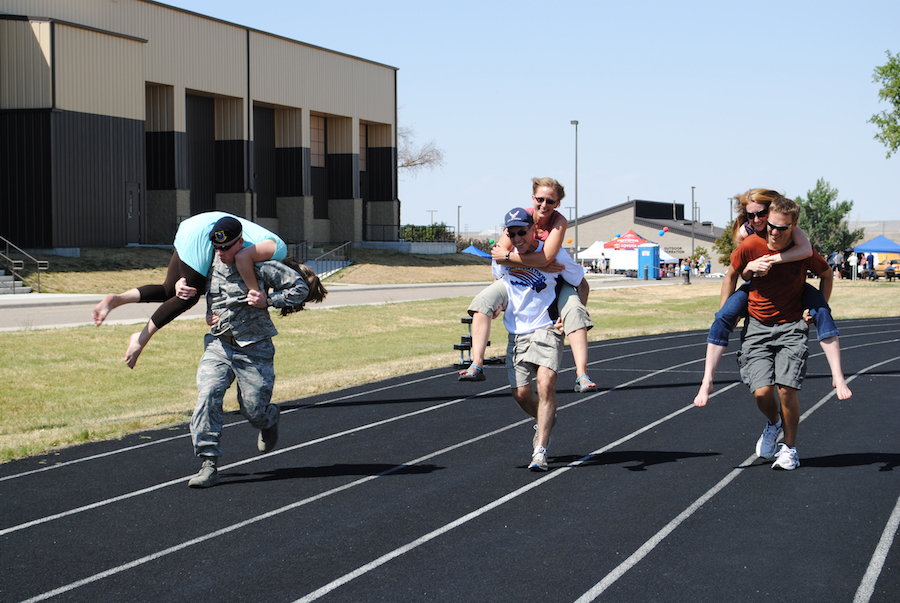
The Aggie explores five strange sports competitions from Europe, North America
With the addition of two new women’s sports to the athletic program earlier this year, UC Davis continues to add diversity in competitions for its student-athletes. However, there is a division of sporting events that cannot be found at most universities. Five of these unusual sports –– while they may not be added to UC Davis’ NCAA list anytime soon –– have earned their own followings and made a name for themselves in their respective cultures.
The first of these sports was started in Finland and is based off of the legend of “Ronkainen the Robber,” a famous thief who was accused of stealing women and wives alongside goods during his village rampages. The sport of wife-carrying was born from this tale and spread across Europe and North America during the 1990s. In North America, the championship event is held every October in Maine’s Sunday River Resort; 13 American winners from different states and two Canadian teams from different provinces compete for the first-place crown. While the teams of two do not have to be legally married to compete, the teammates get close and comfortable with one another, as the sport requires one person to cling onto the body of their counterpart; there is no rule on how the typically female teammate is to be carried. This counterpart then competes in an obstacle course race, and, if the person holding on falls or is dropped, the team is penalized with adding a few seconds to their time. The winner of the whole ordeal is whichever team can complete the course the fastest without dropping the “wife” of the duo.
The second strange sport on the list is considered a tradition by people of all ages in certain regions of the United Kingdom. Every spring, typically in May, the South West England Gloucester region holds the highly-anticipated cheese-rolling competition. This sport has won fame for both its simplicity and its wide range of age-specific competitions. The rules are as simple as the name: competitors stand at the top of a long, grassy hill, and a nine-pound round of Double Gloucester cheese is rolled down from the top. Those competing then have to chase it down to the very bottom, and whoever crosses the finish line first gets to keep the cheese as their trophy. The competition used to be a chasing game, in which the person who could catch the rolling cheese first would win, but the amount of injuries that rule caused forced the overseers of this sport to alter the game. The event takes place on Cooper’s Hill in Brockworth, Gloucester and offers competitions for both adults and children who want to participate in this English tradition.
While the next sport on the list may seem like an adaption of a simple child’s game, it has been gaining fame and fans since the 1970s. Toe wrestling is essentially the feet-version of arm wrestling; opponents are to take their shoes and socks off, interlock their big toes together and attempt to knock their enemy off the ‘toedium.’ Like cheese-rolling, toe wrestling was started as a competition in the United Kingdom when the locals at a pub near Ye Olde Royal Oak Inn in Wetton, Derbyshire thought it would be entertaining to host a toe wrestling competition for themselves and visitors to their town. Although the strange sport was rejected from being added to the Olympics’ roster in 1997, it continues to grow in fame throughout Europe, and the championships are held every year at the Bentley Brooke Inn near the Staffordshire and Derbyshire border.
Unlike toe wrestling, the fourth sport was part of the original Olympic Games, Cotswold Olimpicks, back in 1612, alongside an array of other strange sports in Gloucestershire, England. While there has yet to be a modern Olympian who specializes in shin kicking, it continues to entertain citizens more than 400 years later. The competition starts with two opponents facing each other and holding each other’s collar in a rink. The two are then to kick their enemy in the shins as hard as they can, and each time an opponent falls to the ground, the other player gets a point. The winner of the game is the competitor with the highest score after the end of three rounds. Competitors are permitted to pad their legs with as much straw as they would like and are required to wear soft shoes –– a drastic change from the steel-capped boots that English ancestors were fans of in the past.
The final unusual sport on the list is governed by the Underwater Society of America, the same organization that looks over more traditional sports, such as diving, in the United States. Underwater hockey is played as a mashup of soccer, basketball, and ice hockey, in which six players from two teams compete at the bottom of a swimming pool. Players are equipped with fins, masks, snorkels, gloves, and headwear for protection and are given very short sticks to move the puck around with. Just like ice hockey, the objective of the sport is to score goals in the other team’s net. While playing a sport entirely underwater may seem dangerous, it is reported that players typically only spend no more than 15 seconds underwater, and the success of a team ultimately relies on the players’ teamwork and communication with one another.
While UC Davis’ athletic department is already known for its addition of non-traditional sports in intramural sports, perhaps students will one day see strange competitions such as these added to the list to bring more opportunities for students to try out something new.
Written by: Kennedy Walker — sports@theaggie.org




